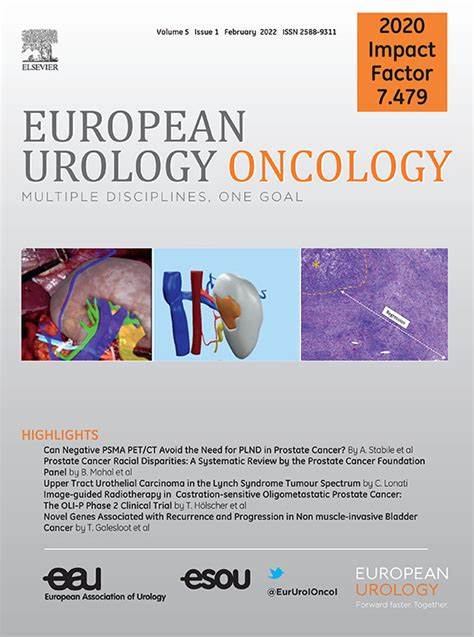[177Lu]Lu-PSMA-617联合或不联合雄激素受体途径抑制剂治疗转移性去势抵抗性前列腺癌的疗效
IF 9.3
1区 医学
Q1 ONCOLOGY
引用次数: 0
摘要
背景与目的:包括VISION在内的大型临床试验已经确定了[177Lu]Lu-PSMA-617与雄激素受体途径抑制剂(ARPI)联合使用的安全性。大多数在现实环境中接受[177Lu]Lu-PSMA-617治疗的患者已经在ARPI中取得进展。本研究旨在评估[177Lu]Lu-PSMA-617在同时使用和不同时使用ARPI的患者中的疗效。方法:我们分析了来自Mayo Clinic Rochester放射药物数据库的数据,重点研究了转移性去势抵抗性前列腺癌(mCRPC)患者,这些患者在先前暴露于ARPI后出现进展,并在2022年3月至2023年3月期间开始使用[177Lu]Lu-PSMA-617治疗。同时接受arpi(阿比特龙、恩杂鲁胺、阿帕鲁胺或达罗卢胺)的患者被确定。基线特征比较采用Mann-Whitney U检验和卡方检验。结果包括前列腺特异性抗原(PSA) 50反应,中位周期数和总生存期(OS),从[177Lu]Lu-PSMA-617开始,使用Kaplan-Meier估计和多变量Cox回归进行分析。主要发现和局限性:256例患者中,106例(41.4%)接受了[177Lu]Lu-PSMA-617的ARPI。接受ARPI的患者基线PSA水平较低(3.4 vs 29.7 ng/ml, p 177Lu]Lu-PSMA-617) (63.2% vs 48.7%, p结论和临床意义:在先前暴露于ARPI的mCRPC男性中,在调整已知预后因素的队列不平衡后,继续ARPI与[177Lu]Lu-PSMA-617并没有改善PSA50缓解率或OS。需要使用大量临床试验数据进行进一步的事后分析。本文章由计算机程序翻译,如有差异,请以英文原文为准。
Outcomes for [177Lu]Lu-PSMA-617 with and Without Concurrent Use of Androgen Receptor Pathway Inhibitors in Patients with Metastatic Castration-resistant Prostate Cancer
Background and objective
Large clinical trials, including VISION, have established the safety of combining [177Lu]Lu-PSMA-617 with an androgen receptor pathway inhibitor (ARPI). Most patients receiving [177Lu]Lu-PSMA-617 in the real-world setting have already progressed on an ARPI. This study aimed to assess the efficacy of [177Lu]Lu-PSMA-617 in patients with and without the concurrent use of an ARPI.
Methods
We analyzed data from the Mayo Clinic Rochester radiopharmaceutical database, focusing on patients with metastatic castration-resistant prostate cancer (mCRPC) who had progressed after prior exposure to an ARPI and started treatment with [177Lu]Lu-PSMA-617 between March 2022 and March 2023. Patients receiving concurrent ARPIs (abiraterone, enzalutamide, apalutamide, or darolutamide) were identified. Baseline characteristics were compared using Mann-Whitney U test and chi-square test. Outcomes of interest included prostate-specific antigen (PSA) 50 response, median number of cycles, and overall survival (OS) from the start of [177Lu]Lu-PSMA-617, analyzed using Kaplan-Meier estimates and multivariate Cox regression.
Key findings and limitations
Among 256 patients, 106 (41.4%) received an ARPI with [177Lu]Lu-PSMA-617. Those receiving an ARPI had lower baseline PSA levels (3.4 vs 29.7 ng/ml, p < 0.001) and lower rates of bone (77.4% vs 87.4%, p = 0.035) and visceral (18.9% vs 34%, p = 0.008) metastases. While patients on ARPIs were more likely to complete all six cycles of [177Lu]Lu-PSMA-617 (63.2% vs 48.7%, p < 0.001), PSA50 response rates were similar (49.1% vs 47.3%, p = 0.786). Median OS was longer with concurrent ARPI use (not reached vs 15.3 mo, p < 0.001), but this difference was not significant on a multivariate analysis (hazard ratio = 1.03 [95% confidence interval: 0.68–1.55], p = 0.891) after accounting for baseline differences in other prognostic variables. Limitations include its single-center, retrospective design and a lack of standardized radiographic response assessment.
Conclusions and clinical implications
Among men with mCRPC previously exposed to an ARPI, continuation of the ARPI with [177Lu]Lu-PSMA-617 did not improve PSA50 response rates or OS after adjusting for cohort imbalances in known prognostic factors. Further post hoc analyses using large clinical trial data are needed.
求助全文
通过发布文献求助,成功后即可免费获取论文全文。
去求助
来源期刊

European urology oncology
Multiple-
CiteScore
15.50
自引率
2.40%
发文量
128
审稿时长
20 days
期刊介绍:
Journal Name: European Urology Oncology
Affiliation: Official Journal of the European Association of Urology
Focus:
First official publication of the EAU fully devoted to the study of genitourinary malignancies
Aims to deliver high-quality research
Content:
Includes original articles, opinion piece editorials, and invited reviews
Covers clinical, basic, and translational research
Publication Frequency: Six times a year in electronic format
 求助内容:
求助内容: 应助结果提醒方式:
应助结果提醒方式:


